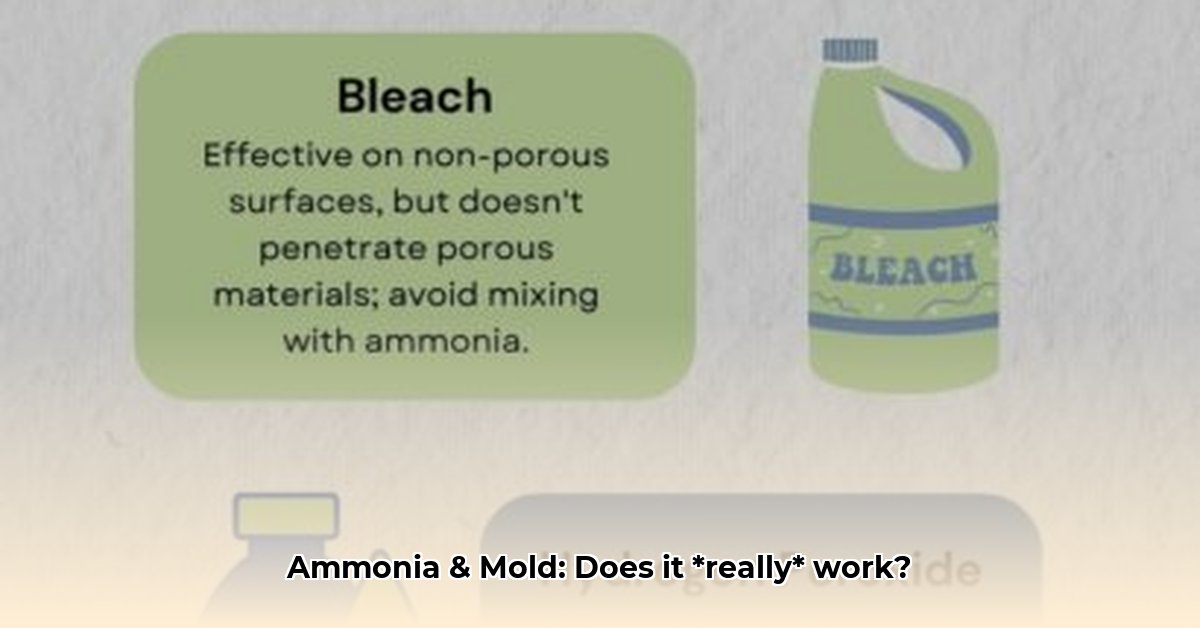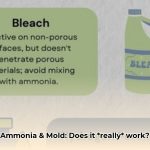Does ammonia kill mold? It’s a common question, and the answer might surprise you. While ammonia is a powerful cleaner, it’s not the best solution for mold, and can even be dangerous. This guide separates fact from fiction, explaining why ammonia isn’t ideal for mold removal and offering safer, more effective alternatives.
Debunking the Ammonia Myth
The idea that ammonia is a universal mold killer is a persistent misconception. While it might kill some surface mold on non-porous materials like glass or tile, it’s largely ineffective on porous surfaces like wood, drywall, and grout—places where mold often thrives. Think of it like this: ammonia may wipe away the visible mold, but it doesn’t address the underlying “roots” (hyphae) that penetrate deep into these materials. Like weeds in a garden, the mold will likely return if the roots aren’t addressed. Moreover, certain mold types, particularly black mold (Stachybotrys chartarum), are highly resistant to ammonia and require specialized removal methods.
The Dangers of Ammonia: More Harm Than Good?
Beyond its ineffectiveness, using ammonia for mold can pose serious health risks. The fumes are highly irritating and can trigger respiratory issues, especially for those with asthma or other breathing problems. Direct contact can also irritate skin and eyes. Perhaps the most alarming danger is the potential for mixing ammonia with bleach, which creates toxic chloramine gas—a potentially fatal combination.
Safer Mold Removal Alternatives: A Comparative Look
Fortunately, there are safer and more effective ways to deal with mold. Here’s a comparison of common methods:
| Method | Pros | Cons | Ideal Use Cases |
|---|---|---|---|
| White Vinegar | Safe, natural, affordable, effective against many mold types | May not eliminate all mold species | General cleaning, light mold growth, preventative measures |
| Baking Soda | Mild abrasive, deodorizes, absorbs moisture, inexpensive | Not a mold killer, primarily for prevention | Mold prevention, odor absorption, light scrubbing |
| Hydrogen Peroxide | Kills mold and mildew, disinfects, readily available | Can bleach certain surfaces, may damage some porous materials | Non-porous surfaces, bathroom mold and mildew, disinfecting |
| Commercial Mold Removers | Designed for tougher mold, wider range of effectiveness, available in varying strengths | Can be expensive, some may contain harsh chemicals, requires careful handling | Stubborn mold, larger infestations (always follow product instructions), effective on porous materials |
When to Call a Pro: Knowing Your Limits
While DIY methods can handle some mold issues, others demand professional help. If you’re facing a large infestation, recurring mold, or suspect black mold, it’s time to call a mold remediation specialist. They have the training, equipment, and expertise to assess the situation, identify the mold type, and safely remove it, preventing further damage and health risks. They can also identify the source of moisture that fueled the mold growth and recommend preventative measures.
Mold Prevention: A Proactive Approach
The best defense against mold is a good offense. Controlling moisture levels, ensuring adequate ventilation, repairing leaks promptly, and regularly cleaning and disinfecting mold-prone areas like bathrooms and kitchens can significantly reduce your risk of mold problems. Consider using a dehumidifier in damp areas or during humid seasons. Some studies suggest maintaining indoor humidity below 50% to inhibit mold growth.
Ammonia for Mold: A Last Resort (With Extreme Caution)
If you absolutely must use ammonia on a non-porous surface (and we strongly discourage it) because no other cleaners are immediately available, proceed with extreme caution:
- Ventilate: Open all windows and doors, use fans to circulate fresh air.
- Protect Yourself: Wear gloves, eye protection, and a respirator.
- Dilute: Mix equal parts ammonia and water.
- Apply and Scrub: Apply the solution, scrub gently.
- Rinse Thoroughly: Rinse completely with clean water and allow the surface to dry thoroughly.
Conclusion: The Right Tool for the Job
While ammonia might seem like a powerful solution, it’s generally ineffective and potentially hazardous for mold removal. Safer and more effective alternatives exist. By understanding the risks and choosing the right tools and techniques, you can effectively address mold problems while protecting your health and home. Remember, mold remediation is a constantly evolving field, and ongoing research may further refine our understanding of mold behavior and its removal. Staying informed about the latest recommendations is always a good idea.
- Does Ammonia Kill Mold? The Truth About Using It for Removal - April 15, 2025
- Does Bleach Kill Spiders? Effectiveness, Safety, and Better Alternatives - April 15, 2025
- Does Soap Expire? How to Tell if Your Soap Has Gone Bad - April 15, 2025










